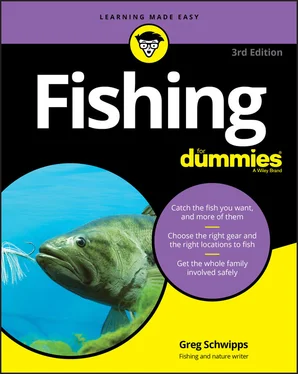It’s not hunting: You can release fish
When a fish is in your net or hand, assuming the fish is legal, you have a choice to make: Do you release the fish, or keep it? (Fish that aren’t legal — due to size restrictions, say, or species-specific rules on that body of water — must be unhooked and released immediately.) With practice, you can easily unhook a fish, and most fish, when fought to the bank properly, will zip off unharmed when released back into the water.
If the fight has been particularly long or grueling, the fish might be fully exhausted, in which case you might need to revive the fish before you release it. Chapter 18describes how to revive and release an exhausted fish.
Releasing fish ensures that other anglers will have the chance to catch fish, and releasing a trophy is a way to keep the right genes (the kind that make big, healthy fish!) in the pool. Of course, as mentioned in Chapter 19, be sure to get a picture of that award-winning fish before turning it loose.
But fish taste great, and you can keep a few, too
Because a fish’s body is made up primarily of muscle, they are a great source of protein. With practice, it’s possible to clean fish efficiently and with a minimal amount of gore. When properly cleaned, fish can be cooked in many different ways, pleasing even the most discerning palate.
Chapter 21includes recipes for preparing different kinds of fish in a variety of ways. Most of the recipes come from noted chefs Lucia Watson, award-winning chef and founder of Lucia’s in Minneapolis, and Peter Kaminsky, a cooking writer and one of the authors of this book. You’re sure to find a new favorite dish.
Chapter 2
Gathering What You Need to Fish
IN THIS CHAPTER
 Dressing smarter for fishing
Dressing smarter for fishing
 Packing a foul-weather bag
Packing a foul-weather bag
 Making waders work for you
Making waders work for you
 Picking the right tackle carrier
Picking the right tackle carrier
 Staying legal while fishing
Staying legal while fishing
Be prepared. That’s good advice that the Boy Scouts of America have followed for over 100 years now. Some people want their trips to be spontaneous, fun, and unpredictable. Others don’t get to go fishing as often as they would like (who does?) and so want every minute they get on the water to be as enjoyable and stress-free as possible. And that means being prepared for the unplanned things that inevitably happen while fishing.
And being ready doesn’t mean your fishing expeditions will somehow lack spontaneity or fun. On the contrary — the more prepared you are for a trip, the more energy and time you can dedicate to the important stuff: the fishing. That’s the enjoyable part, after all. No one has fun fishing in the rain while cold and hungry, knowing your rain suit and lunch are back at the house.
This chapter gives you an overview of the basic things you might need before you hit the water. Don’t worry — you won’t need everything for every trip; the less you have to carry, the better. But I offer advice here for what to wear and what to carry that prepares you for most of your fishing excursions, most of the time. (If you still want to go fishing on every single trip looking like a total rookie, absolutely clueless to what’s happening in the world around you, go ahead: My brothers have been doing it for decades, seemingly with no ill effects.)
Dressing for Fishing Success
If you want to take up fishing because you like the idea of impressing other anglers with your latest outfit, you, my friend, are going into the wrong hobby. Or you’re going into the right hobby for all the wrong reasons! What you wear while fishing isn’t about impressing other anglers. But it should be about comfort and success.
You desire clothes that are comfortable, and you also want them to work for you in all weathers. Hemingway writes in The Old Man and the Sea: “Anyone can be a fisherman in May.” And May fishing can be quite pleasant. It can also be cold, rainy, stormy, and downright nasty. And you’re not only going to fish in May, are you? You want the right clothes for all seasons and all conditions.
As strange as it sounds, you also need clothes that help you catch fish. You want to wear clothes that don’t scare fish by giving away your position, and you need gear that lets you get as close to the fish as you can while being as quiet as possible. But have no fear: I'm not talking about getting ready for the prom here. The clothes you wear while fishing can be inexpensive, old, and ratty. They probably should be. But you should think a little bit about what you’re wearing, beyond that lucky feeling you get from your Bon Jovi t-shirt.
Wear layers and always be happy
You don’t need to dress better, you need to dress smarter. Wearing layers is the key to adapting to changing weather conditions while fishing. Even on a calm, sunny day, you face big temperature swings on a typical fishing trip. When you start out, possibly before dawn, the day begins dark, chilly, and damp. Four hours later, you find yourself under a blazing sun cooking you with 95 degrees of oven-blast heat.
Of course, the weather can change beyond the normal progression of the sun, as well. Storms blow in, rain starts and stops. Winds pick up and die down. One outfit won’t match all of these ever-changing conditions. Even with the latest clothing technology, which really is quite amazing, you need to dress in layers to be comfortable all day or night when fishing.
The basic setup in the following list will serve you in most places, most of the time. Modify it when it’s ultra-hot, like in the tropics with no chance of anything remotely cool happening or, at the opposite end of the weather spectrum, when it’s cold and going to stay that way, such as Lake Michigan in November. Outside of those extremes, follow this list and you’ll be prepared for weather from about 40 degrees F to 90 degrees F, which is the range at which most of us fish:
Against your skin: Start with a regular old cotton t-shirt and shorts or pants in all but the coolest or hottest weather. If it’s going to be really hot, go with a lighter, more breathable nylon/polyester-blend shirt. If it’s going to be really cold, put on your baselayer first.
Baselayer: In cold weather, a baselayer made from merino wool, nylon, polyester, spandex, or fleece will amaze you with its comfort, thinness, and warmth. Baselayers should be worn right against the skin.
Shorts (with pockets): Even if you choose not to wear them while fishing, throw a pair in your car for the ride home.
Pants, jeans, khakis: If you don’t like cotton, wear something made of a synthetic material like nylon, spandex, polyester or fleece. These materials often have a sun-blocking rating of 50 UPF (ultraviolet protection factor) or so, and can also be stain-resistant. Make sure your fishing pants have plenty of accessible pockets.
Long-sleeve shirt: Even when it’s hot, it’s a good idea to always wear a long-sleeve shirt to keep the sun off. Most of you know that prolonged exposure to the sun is dangerous for unprotected skin. And fishing is a pastime that gives you about as much sun as any human activity. Modern shirts have sun-blocking capabilities built right into the fabric, and advertise the UPF on the label.
Читать дальше

 Dressing smarter for fishing
Dressing smarter for fishing










